Photos
-
Heirloom Plants
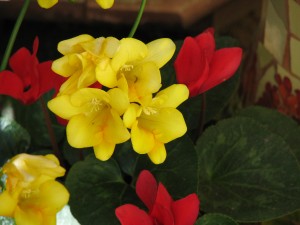
- Fragrant Antique Freesias and Cyclamen
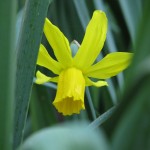
Little Witch Daffodil I am so fortunate to live here in Northern San Diego County, where Spring has come and gardening weather is wonderful. I may be a cold-weather wimp, but that’s okay. A morning filled with the scent of freesias and the repetoire of a mockingbird in love fills and feeds my inner self. I wish that I could waft that incredible fragrance to you from the photo! I was born in New Jersey, the youngest of five, and we came West when I was five years old. My mother never wanted to even look at snow again in her life, and my dear dad made that possible. I published a fiction story some years ago in the premier children’s magazine, Cricket ( http://www.cricketmag.com/CKT-CRICKET-Magazine-for-Kids-ages-9-14), called Taking Tea with Aunt Kate. In it I wrote about a lush, mixed-up garden. The illustrator for the story lived in some cold state, and emailed the editor with alarm that I had daffodils blooming at the same time as squash was in the garden. It took me a little to convince her that our narcissus bloom in early Fall when squash is still being harvested, and daffodils are still blooming when we can transplant squash starts out in the Spring.
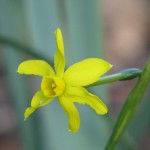
Early Louisiana Jonquil 
- Van Sion (1620)
Despite the fires, drought, and cost of living, we live in an Eden most of the time, in my opinion. But I’m well off the track of what inspired me writing this morning.
I revere heirloom plants. I became involved with heirloom varieties when I was a Senior Park Ranger for the County of San Diego, and was in charge of the newly restored Rancho Guajome Adobe in Vista. http://www.co.san-diego.ca.us/parks/ranchoguajomeadobe.html . If you haven’t visited, you really need to. Its right next to the Antique Gas and Steam Engine Museum http://www.agsem.com/ and open for tours on weekends and for special events. The most common comment has always been, “I’ve lived in Vista for years and driven past this place almost daily and never knew it was here!”

Tommies crocus (1847) Anyway, for the Adobe’s grand opening after it’s restoration, I was asked to create a Victorian wedding area using period-appropriate plants. In about 8 weeks. And, in one of the fastest group efforts ever, I did. Since different areas of the Adobe were built and interpreted for different times, I researched and planted gardens in the inner courtyard and in the front which reflected the plants available in San Diego at those times. The gardens have changed plant materials over the years, but have been lovingly kept by docents and staff. Two wonderful resources (among many) which I still shop from and refer to today, are Old House Gardens Heirloom Bulbs https://www.oldhousegardens.com/index.asp , and Heirloom Roses http://www.heirloomroses.com/index.htm. These are two mail-order plant suppliers who research and care for their stock, listing introduction dates and histories. Old House Gardens is particularly warm and fuzzy to deal with; they add personal notes onto the orders, want feedback about how the bulbs do in your area, and make sure that you know if
Cherokee Rose 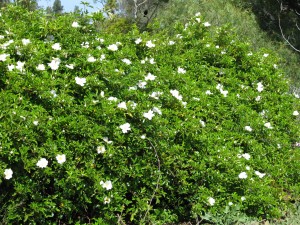
A cutting from the Cherokee Rose planted at Rancho Guajome Adobe circa 1880. So in my gopher-populated garden at home, I have been building bulb beds which are set on landscape fabric (to try and keep out the Bermuda grass which can grow anywhere) and lined with aviary wire. This is the time of year when these beds make my heart soar, because one after another these incredible flowers tell me more than anything that Spring is here. Daffodils aren’t supposed to be appetizing to gophers, so in January I bought a couple of bags of the common King Alfred variety (45 in a sack for about $7!) at Home Depot, and planted them all over. I got them in the ground a little late, so I may have to wait until next year for blooms. I love the explosion of daffodils all over Santa Ysabel and Julian.

Rosa rugosa, our native rose I have far too many roses planted; but I have to confess, one of the real perks of the permaculture work that is being done on the rest of the property is that I get to have more roses! 🙂 My side yard has the destinguished personages of Agatha Christie, William Shakespeare, along with Double Delight, Blue Girl,
 Blue Girl
Blue GirlMirandy, and some big red rose that was here when I moved in. Two Damask roses (which they use to make Attar of Roses) that my nephew gave to me are in the front, along with Rosa rugosa (our native) and some unidentified ones. The driveway is filled with artistocratic names along with Joseph’s Coat, and beginning to work its way up the post that stands outside the bedrooms is Kiss of Desire. (Sigh). In the back are many more which were here when I moved or came to me free and unlabeled, including two spectacular red roses which are side-by-side, are now enormous and lush, and whose bloom colors clash so loudly you could hear it inside!
Although they aren’t native, many of these heirlooms need to be saved from extinction, are often much hardier than any modern hybrids, and are gorgeous and unique. They have to be hardy, because my plants need to thrive on some neglect. I also fertilize them with Roses Alive natural fertilizer from Gardens Alive http://www.gardensalive.com/ . Organic fertilizer doesn’t build up salts in the soil or destroy the soil microbes that are essential for good plant health.

Unidentified David Austin rose About the recommendations: I don’t work for any of these businesses. I recommend them as a friend, for I have found them to be excellent in my dealings with them and they support good causes. I hope that you enjoy their breathtaking catalogs! (I actually have to go through the catalogs a little at a time because I get too excited and my heart rate goes up and I want all they have!).
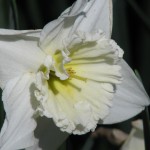
Ice Follies daffodil So this was a long post, when actually this beautiful bird-song-filled morning I just wanted to bring you photos of Spring flowers, to brighten your day. Also, I’ve been trying to learn this user-friendly (ha!) blog thing, and I think I’ve made it possible to leave comments without you having to go through so many hoops (to prevent spamming.) I’d love to hear what you say! Have a great day.
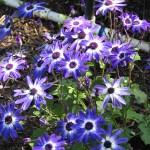
Cineraria 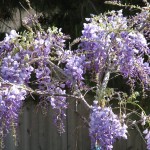
Wisteria chinensis -
The Monster in the Pond
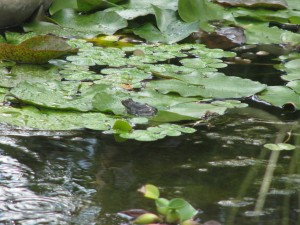 Ok, ok, I’ll succumb to popular demand and tell my pond story. A number of years ago I came into possession of free pond liner and flagstone. My daughter and I hacked down a juniper that had taken over our front yard, pickaxed out all the roots and rocks, and after watching many YouTube how-to videos, built our Perfect Pond. I indulged in waterlilies, a priceylotus, and some other cute little water plants. We set free a few mosquito fish, and enjoyed our organic water feature. Well, it was better than we ever thought. It attracted birds, dragonflies, and Pacific Chorus Frogs. In fact, in early February, every frog in the county makes its way over to our little 400 gallon pond and begins their mating calls. They are so loud that we’ve had to shine a flashlight out the window at night to quiet them down to hear a movie! Soon we had evidence of amphibian genetic success.
Ok, ok, I’ll succumb to popular demand and tell my pond story. A number of years ago I came into possession of free pond liner and flagstone. My daughter and I hacked down a juniper that had taken over our front yard, pickaxed out all the roots and rocks, and after watching many YouTube how-to videos, built our Perfect Pond. I indulged in waterlilies, a priceylotus, and some other cute little water plants. We set free a few mosquito fish, and enjoyed our organic water feature. Well, it was better than we ever thought. It attracted birds, dragonflies, and Pacific Chorus Frogs. In fact, in early February, every frog in the county makes its way over to our little 400 gallon pond and begins their mating calls. They are so loud that we’ve had to shine a flashlight out the window at night to quiet them down to hear a movie! Soon we had evidence of amphibian genetic success.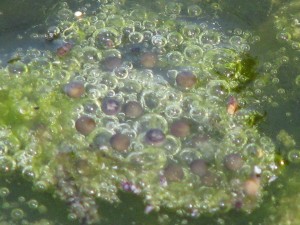
Frog spawn! Then tadpoles, and tiny frogs that mostly disappeared somewhere until the following February. The mosquito fish found similar romantic success and soon numbered in the hundreds.
Other than giving the non-human youth a Lover’s Lane, as it were, the pond had its ups and downs; the raccoons just loved getting in and knocking over the expensive lotus plant, so it never flourished. Some very creepy flat-headed black wormy things appeared in the filter, the dragonfly larvae looked like the stars of B-movies in miniature, and some of the plants tried to take over the world. After a few years, I decided that there was too much plant growth and it needed to be thinned out. With rubber gloves on hands and an explorer’s enthusiasm, I went in. (Oh, and by the way, NEVER put pea gravel in your pond, no matter how many people say to on the Internet or in books. It’s too sharp to stand on, it can wreck your liner with its pointy edges, and it makes a dead biomass on the bottom of your pond. Thanks, I had to say it. I hate pea gravel. That’s my rant for the night.)
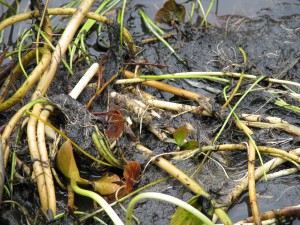
So I was doing all right, standing in my knee boots, groping around under the murky water pulling and untangling long root and stem systems of these too-happy plants, when suddenly…. I felt something. Something that wasn’t right. Something that was too large to belong in our little pond with its one gallon happy plants in it. Something that felt long and nobby like a huge slimy neckbone. A monsterous, nobby, slimy neckbone.
Now, I’m not a squemish person, nor one to back down at a challenge, but this THING was so not right that I was dropping it and getting my boots out of that pond pronto. After watching to see if it had followed, and satisfied that it hadn’t taken offence, I decided on perhaps an abridged version of the ten-foot-pole ploy, and used a rake to gently heave it out of the water. It was all tangled up in my wonderful waterlily leaves, so I tried to untangle as gently as I could, crooning soothingly to it as I worked. Then, to my horror, I discovered that …. the monster neck WAS my sweet little waterlily! How could that have happened? In only three years!
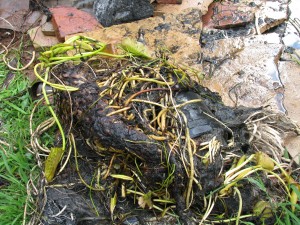
The one gallon black plastic pot had apparently fallen over (thank you, racoonies), and this plant wasn’t going to wimp out like the lotus. Ohhhh no. It grew out of the pot and made a U-turn heading back towards the light. The neck was about 3 inches in diameter, about the size of a human’s, I’m guessing, but more alien. Observing the true underwater nature of my waterlily made me feel like Rosemary of Rosemary’s Baby fame: my little darling was a slimy hideous monster. So, I did the only rational thing I could think of. I shoved the whole darn thing back into the pond, prodded it with the rake (the plant grabbed the tines, I know it did!) until I couldn’t see it anymore (the arch of the neck kept protruding from the water surface! I had to almost beat it underwater). Then I went in the house and had a hot bath to get the slime and smell off of me, and try to recooperate. You bet I locked the doors.
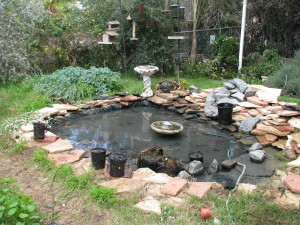
In conclusion, the invasive pond plants were ripped out, I exchanged some water to help keep the biomass alive, and I learned something about myself. I’m not afraid of black widow spiders, snakes, heights, caves, or blood. I am, however, afraid of two things. One has been a long-standing fear of high-school-aged students, dating back to before I even was one, and I don’t think anyone will challenge me on that one. The other thing I’m afraid of is that waterlily in my pond. Its been several years now since this incident, and under the water its been growing… growing…. I haven’t waded back in there since.
-
Easy and Incredible Buttermilk Chocolate Ganache Cake with Perfect Chocolate Frosting
A rare thunderstorm in San Diego, after days of 100+ degree heat. A few drops of rain and enough crashing to make my dogs nervous. They are happily taking advantage of my push-over self and are in the living room, while my cats are furious in the rest of the house. The cooler fallish weather and darker skies makes me want to cook!
I bake for friends, and this is one of my most requested cakes. It is easy, it is wonderful, it is satisfying: it is chocolate. I don’t like wimpy chocolate cakes; if I’m going to invest my calories in a dessert, it better pay off in flavor and texture. Making this cake a day ahead allows the flavors to meld, but it can be eaten right away in case of chocolate emergency. This recipe does use dairy products, and the acid reaction between the buttermilk and baking soda helps it rise and makes the chocolate flavor be yum. I have directions for a layer cake or sheet cake, but it makes great little bundt cakes, too. I have a humongous sheet cake pan and I quadruple the recipe with complete success. I’ve given directions for chocolate frosting, which is absolutely great, by the way, but feel free to use other colors for decorations. Although I enjoy dark chocolate, I find semi-sweet is best in the ganache, although I’ve used extra-dark baking cocoa for the batter and frosting with much success. Enjoy!
Easy and Incredible Buttermilk Chocolate Ganache Cake with Perfect Chocolate FrostingAuthor: Diane KennedyRecipe type: DessertPrep time:Cook time:Total time:Serves: 10 - 12My best and most satisfying chocolate cake recipe, without a lot of hassle!Ingredients- Buttermilk Chocolate Ganache Cake
- For Cake:
- 2 cups white sugar
- 1 ¾ cups all-purpose unbleached flour
- cups powdered unsweetened baking cocoa
- 1 ½ teaspoon baking powder
- 1 ½ teaspoon baking soda
- 1 teaspoon salt
- 2 eggs
- 1 cup buttermilk
- cup vegetable oil
- 2 teaspoons vanilla extract
- 1 cup boiling water
- For Ganache:
- cup heavy cream
- 2 tablespoons unsalted butter
- 4 ounces semi-sweet chocolate in pieces
- For Frosting:
- 1 stick (1/2 cup) butter
- ⅔ cups powdered unsweetened baking cocoa
- 2 cups powdered sugar, sifted
- ⅓ cups milk, water or buttermilk
- 1 teaspoon vanilla
Instructions- Heat oven to 350 F.
- Grease and flour 2 9-inch round baking pans, or one sheet cake pan.
- Combine dry ingredients in a large bowl.
- Add eggs, milk, oil and vanilla; beat on medium speed for 2 minutes.
- Stir in boiling water (batter will be thin).
- Pour evenly into baking pan(s).
- Bake 30 – 35 minutes, or until wooden toothpick inserted in center comes out cleanly.
- Cool ten minutes.
- For layer cake, or for the more adventurous sheet cake bakers, turn cake(s) out onto wire racks and cool completely.
- For ganache, combine heavy cream and butter in a small saucepan and bring to a simmer.
- Turn off heat.
- Add the chocolate pieces and swirl around to cover them with the hot milk mixture, and then cover for five minutes until chocolate is melted.
- Stir until smooth and creamy.
- Pour into a small bowl, cover and refrigerate until ganache is thick enough to spread.
- For frosting, melt butter and pour into bowl.
- Stir in the cocoa.
- Alternately add sifted powdered sugar and milk, beating on medium speed to spreading consistency.
- Add more milk if needed.
- Stir in vanilla.
- Makes about 2 cups.
- To finish: If making a layer cake use the ganache as filling.
- Cake may then need to be chilled to keep ganache firm before and after frosting. Ganache can also be used both as filling and as a coating for the top layer, and the frosting spread around the sides of the cake and piped decoratively around the top edge as a barrier to contain the ganache.
- If making a sheet cake, spread thickened ganache on top of cooled cake.
- Pipe frosting decoratively around edge to contain ganache and, if you’ve managed to turn the cake out of the pan, spread the frosting around the sides.
- This cake is excellent if made the day before serving, to give the flavors a chance to meld.
-
What to do with Pomegranates
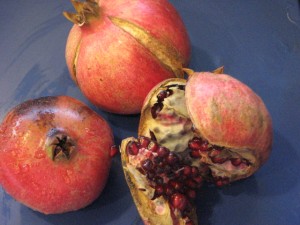
Pomegranate trees are beautifully exotic. The deciduous shrub has glossy green leaves, bell-shaped crimson flowers that hummingbirds love, and heavy handfuls of round purse-shaped fruit loaded with edible seeds. In the heat of Southern California October, pomegranates evoke colorful images of ancient Persia, the splashing of cooling fountains and the scent of roses and orange blossoms. Closer to the holidays they are joyful decorations and eloquent additions to special menus.
This partially explains why on a dry and sweltering 99 degree October day I’ve gathered pomegranates off my tree, many of them split by the heat, and am laboriously harvesting the seeds dressed in my shorts and bikini top. I know I am doing myself a favor for later.
Whether you buy or grow pomegranates, there are three basic ways to prepare them: you break them open and eat the seeds, you remove the seeds to use in recipes, or you juice them. Actually, the seeds are the little black bits inside the red flesh, and what we call seeds are called arils. To make this easier on all of us, I’ll call them seeds.
To buy pomegranates, find heavy, glossy red fruits from September through about February. Make sure they don’t have any really soft spots on them. Store them decoratively in bowls for a week or two, or in the refrigerator for longer.
To eat fresh, find yourself a stain-proof area: this is messy and the juice stains. Cut the top off the fruit, make a slit down the side and with your thumbs or with the tip of the knife, pry it apart. This should be quite easy if the fruit is ripe. Inside are sections of glossy, deep red juicy seeds encased in a bitter white cushion called pith. If you say this word around anyone with a middle-school sense of humor you will be treated to an explosion of giggles. Anyway, you eat the seeds. They are not very sweet, but they should not be overly sour, either. Whether you just consume the juicy part and spit out the inner black bit (the real seed) or not is a matter of taste; they are good for spitting contests (outside!). However that little black seed holds the most fiber, so crunching away is healthier.
To juice, you can cut the fruit in half and use a juicer, or remove the seeds as noted below, and whirl gently in a blender. For either method you need to strain the juice through cheesecloth. The problem with the juicer method is that some pith does get into it, making the juice bitter. If you are using the juicer, a hand one or one that presses the fruit rather than an electric one that whirls is better. You don’t want any of the bitter pith to be grated into it. If using a blender, liquefy quickly without causing it to foam, or it won’t strain quickly. Two cups of seeds makes about one cup of juice. Drink as is, chilled or slightly warmed, or use to make molasses, syrup, grenadine, marinades and sauces. Store in the refrigerator.
Pomegranates are acidic so avoid using aluminum and carbon steel knives or pots as they can turn the juice bitter.
To prepare the seeds for recipes, this is what you do:
Dress in old clothes.
Set a bowl of water in the sink (this isn’t like shelling peas while sitting out on the porch rocker with the bowl on your lap. You need damage control!).
Put out a container for the pith. (!) I compost it, and hopefully you can compost, too.
Put out another bowl and a sieve for the finished seed.
Set up a cutting board with a paring knife.
Make sure you have a sponge handy.
Put on a good audio book or CD. I was listening to classical selections while doing this.
On the cutting board, slice the very top off a clean pomegranate and slice down the side, just through the outer layer. With your fingers or tip of the knife, crack the fruit open.
This is important: submerge the fruit in the bowl of water! (unless you like the ‘someone was just murdered here’ look for your kitchen walls). In the water, slide your fingers under the seeds to separate them from the pith, without squishing them much (you don’t want to lose the juice). If you start daydreaming and the fruit comes out of the water, it will squirt. Use that sponge on the walls, etc. Compost or discard the pith and shell. Pick out any pith that is floating in the water. It is edible but bitter.
When finished, or when the bowl is getting full, some of the extra pith will be floating on the top, so try draining it off, or skimming it with a small sieve. Then drain the seeds into a large sieve and put them in a bowl until you have seeded all the fruit you are going to do, or are just tired from standing.
The seeds can now be used fresh in recipes, juiced, or frozen in sealed freezer baggies. One 9 oz pomegranate holds about ¾ a cup of seeds. I’ve used frozen seeds on top of fruit salads or with certain main dishes over the holidays.
I’ve let smaller, less ripe pomegranates stand on flat platters (not touching) as decorations, and they have dried well for use in arrangements.
Nutrition:
One half cup of arils (87g) has 80 calories, zero fat and 5 grams of dietary fiber (if you eat the whole aril), one gram of protein, and vitamin C, iron, and very high amounts of antioxidants.
The Pomegranate in History:
Many scholars believe that Eve’s apple in the first book of the Christian Bible was actually a pomegranate, which is the right size, shape color, and most importantly, grew in that area. The name pomegranate comes from the Latin word for apple, pomum and seeded, granatus. Indeed, the heavy red fruit with crimson arils bursting with juice against the soft white pith can be, lets say, food for thought. Ahem. No surprise then, is its symbol of fertility, new life, and most good things. Pomegranates hold strong symbolic meaning in Judaism and the Greek Orthodox Church. In Greek mythology, Persephone was tricked into eating pomegranate seeds by her kidnapper Hades, and could only then return to the world that many seasons (the number varies depending on the number of dry seasons). During the months of Persephone’s absence, her mother Demeter’s (goddess of the harvest) mourning kept anything from growing, explaining winter.
Trivia: the Spanish capitol was renamed Grenada after the fruit during the Moorish occupation.
